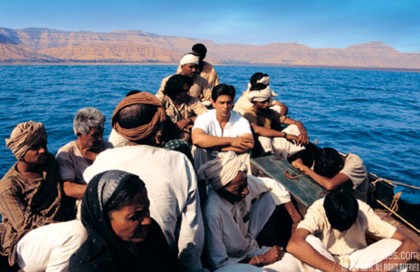|
After 'Lagaan', Ashutosh Gowarikar joined the illustrious group of filmmakers who have put Indian cinema into the international terrain. Gowarikar’s second film, ‘Swades: We the People’, starring India’s biggest star, Shahrukh Khan, was the most eagerly awaited film of 2004. The central theme -- the returning NRI – gave it a special significance to Indians everywhere.
Ever since Aditya Chopra made ‘Dilwale Dulhania Le Jaayenge’ in 1995, NRIs flooded Hindi films, singing ‘bhajans’ wearing miniskirts and Gap T-shirts. A whole new cinematic genre spun out of this blockbuster, depicting modern Indian families living in designer homes in London, Toronto, NY, LA, espousing glories of Indian culture and traditional family values. These films struck a strong emotional chord in the hearts of every Indian abroad and became money-spinners for filmmakers of every ilk. Every month a film is announced aimed at the NRI, filled with patriotic sermons and the mandatory songs and dances and wedding sequences.
‘Swades’ too is about the love of the nation, one not expressed by waving the tricolor or mouthing slogans. It is about an NRI who returns to his roots to work for his community. Inspired by Rajni Bakshi’s ‘Bapu Kuti’, a book about real-life individuals involved in community development, Gowariker conceived this subject in 1996. The result is Swades -- an attempt to shake Indians out of their apathetic insensitivity to the issues that have hampered the development of India and to urge them to actively take responsibility for the country’s welfare at the grassroots level. ‘Swades’ reminded me of Hrishikesh Mukherjee’s Namak Haraam (1973) where a middle-class youth moves to the slums to help a friend, and gets so involved that he gives up all material comforts and turns socialist-activist.
But that was over 30 years ago, this is now. That was class-divide, this is about multiple divides that segment modern India -- class, caste, gender, urban-rural, national-international. ‘Swades’ is the story of Mohan Bhargav, a young scientist managing NASA’s Global Precipitation Measurement Project. Caught up in the pursuit of professional achievement, Mohan has forgotten his past, and on his parents’ death anniversary, feels the guilt of abandonment. He decides to take a break and return to India to bring his childhood nanny, Kaveriamma, back with him to the US. At this point, it is purely a personal quest -- Kaveriamma is symbolic of the parental love and nurture that every NRI leaves behind. The search for this mother figure takes Mohan from Florida to Delhi to a remote village in Uttar Pradesh, an actual journey that parallels an internal journey toward self-discovery.
Mohan reaches Charanpur (a fictional village recreated near Panchgani) in his 5-star RV, carrying with him every comfort the NRI is used to. In direct contrast, Charanpur is beset with problems integral to rural India -- poverty, illiteracy, ignorance, prejudice, gender discrimination, scarcity of basic amenities. The Panchayat that governs Charanpur continues to perpetuate traditional notions of a rigidly hierarchical society. Mohan remains an outsider, emerging from his RV, clad in jeans, plaid shirts and sneakers, greeted with awe and skepticism by the villagers. Gowarikar’s objective is to juxtapose Mohan’s move from the highest level of technological advancement to a space untouched by basic developmental issues, and the encounter becomes a two-way transaction. Just as the villagers learn to cast away regressive values and work together to facilitate progress, Mohan learns about the individual’s responsibility to the community.
Mohan’s journey continues into the interiors of rural India where he encounters the extreme impact of poverty and caste oppression. A child peddling water to passing trains turns into an epiphany, a transformative experience that leads him to extend his stay and actively initiate change. He successfully bridges the caste divide, eases the entry of girls and scheduled-caste children to school, and takes on a project that demonstrates the strength of unity fortified by technical knowledge. As a parallel to the cricket match in ‘Lagaan’, Mohan gets the villagers to work together to successfully harness natural water to generate electricity.
The film is a strong statement against brain drain. At the end of the film, one of the characters deconstructs the myth of the American dream. The desire to live and work abroad is compared to using the lamp from one’s own home to light up the neighbor’s house. This statement haunts Mohan all through the completion of NASA’s project back in Florida. Without mincing words,
'Swades' tells us that the NRI needs to return to his/her roots to apply the knowledge and education he/she has acquired.
'Swades' also has a distinct relevance to contemporary reality. Many NRIs are returning home, not just because they've been laid off, or because they want their children learn about India, or because they want to live close to their families, but because they want something beyond material comfort.
This is not a recent phenomenon. Many of the NGOs working on rural and urban development in India since the 1960s were initiated by NRIs. The difference is that the current economic boom has created conditions that offer NRIs a lifestyle similar to what they leave, which compliments the notion of ‘returning home’. Encouraged by the burgeoning wealth of urban India and multiple professional opportunities, satiated with the fast-paced career-driven lifestyle, several professionals are returning to India out of choice, investing material resources, skills and experience into innovative projects. Mohan Bhargav is the quintessential emblem of the returning NRI -- one who thinks globally, acts locally. On celluloid it becomes a simple choice, a highly romanticized Utopian version of the ‘Return of the Native’, the savior who will single-handedly eradicate all the evils in society and lead the community to enter hand in hand into a brave new world.
The film, with its muted tones and earth colors has none of the flash of NRI films made by Karan Johar or Yash Chopra.
'Swades' is peopled by unknown faces, the only star being Shahrukh Khan. In fact, Khan’s induction in this genre of film is a cinematic technique used by Gowarikar to make his leading character an outsider in a crowd of anonymous villagers. To his credit, Khan is brilliant in this film. He avoids his characteristic mannerisms, designer clothes, hamming tendencies and enters the soul of Mohan Bhargav, poignantly portraying Mohan’s metaphorical journey of self-discovery. One can relate all over again to the insidious charm of this ordinary boy next door who became a super star. Giving him company are a myriad of colorful characters with unique idiosyncrasies, adding humanity to the film’s bipolar perspectives. Beside Mohan is the luminous Geeta, the urban girl who has moved to this village to teach children. Portrayed with dignity and grace by debutante Gayatri Joshi, Geeta is more significant than a romantic foil -- she acts as Mohan’s conscience and his inspiration to eventually quit his job at NASA and return to his roots.
Unfortunately, the film is not without flaws At 210 minutes of playtime, with repetitive platitudes, romanticized conclusion, the film tends to meander into the realms of a promotional documentary. Unfortunately, Gowarikar cannot avoid the pitfalls of commercial needs and uses Bollywood style awareness raising songs as a tool of social reform. Some song sequences are redundant, albeit set to the tune of A.R. Rahman’s haunting melodies. A little less of telling and a little tighter showing would have gone a long way.
There are also few discrepancies, as the level of ignorance is not in consonance with the small town feel of this fictional village. It is a village near a highway with brick constructions, yet there is no awareness whatsoever. Where are the rural development initiatives that have been prioritized in Indian policies for the last decades? Why are there no traces of an India that nurtures the greatest technical minds of the world, produces hi-tech marvels, and is the home of the BPO, ODCs, Call Centers? And is it only the responsibility of the NRI to bring about social change? Accusations of abandonment can be aimed at all the educated professionals living in Bangalore, Hyderabad, Delhi or Mumbai, caught up in the pursuit of material success, spending their paychecks in 5-star hotels and shopping malls. Granted, they are contributing to Indian economy by (hopefully) paying taxes and have evaded the lure of the brain drain, but perhaps they could also be persuaded to join hands with ‘Big Bwana’ Mohan Bhargav.
But flaws withstanding, 'Swades' is a movie I strongly recommend every Indian to see, because it directly addresses each one of us who has left something behind. It urges us to pause and think whether the journey has been worth it, to consider the option of going back, or to think of a middle path where we can continue our journey without forgetting our connections to what we have left behind.
YOUR COMMENTS:
Tell us what you
think of this feature. Write to us at contact@nripulse.com.
|



